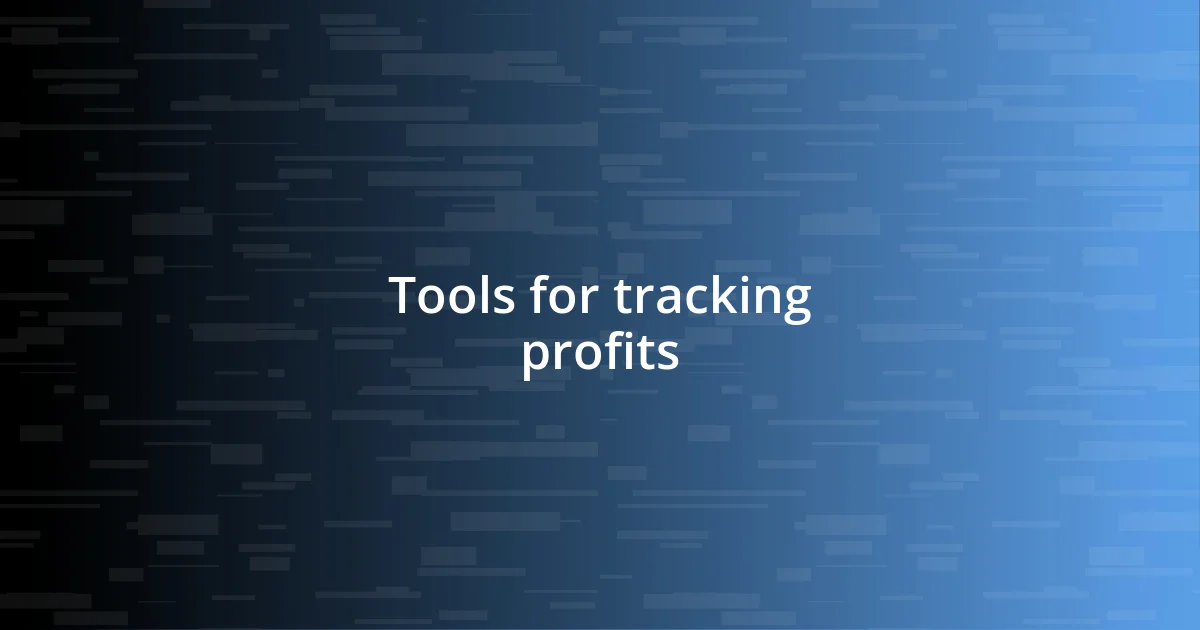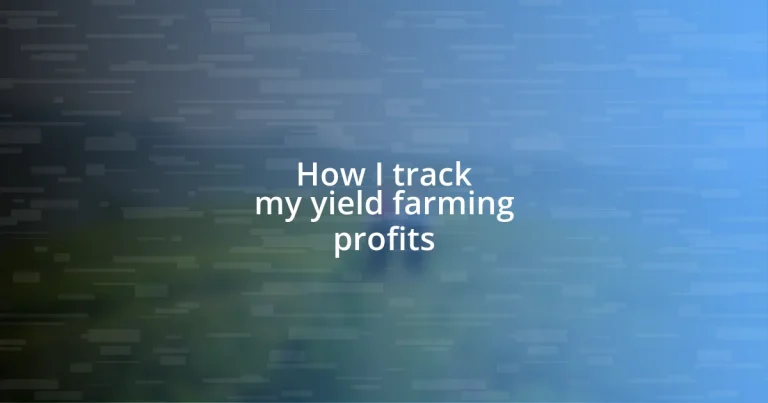Key takeaways:
- Understanding yield farming profits requires awareness of metrics like APY and factors such as impermanent loss and transaction fees.
- Utilizing tracking tools and spreadsheets enhances visibility and organization of investments, enabling better decision-making and trend analysis.
- Evaluating yield farms involves looking beyond superficial metrics at aspects like community trust and historical performance, alongside recognizing risks associated with high APYs.

Understanding yield farming profits
Yield farming profits can be a bit elusive, especially if you’re just starting out. I remember my first venture into this space; I felt overwhelmed by the various metrics and numbers. It’s not just about how much you invest, but also how you track the returns over time, which can fluctuate wildly depending on market conditions.
When I first learned to measure my yield farming profits, I discovered that understanding what yields really mean—like APY (Annual Percentage Yield)—was crucial. It’s exciting to see strong percentages, but I learned the hard way that those numbers can be misleading if you don’t account for impermanent loss or transaction fees. Have you ever looked at a high APY and wondered what lies beneath? It’s definitely worth digging deeper and make sure your profits are real.
I often find myself revisiting my records to understand trends in my profits, especially during market downturns. Just a few weeks ago, I noticed a dip in my usual returns. It was disheartening, but it pushed me to analyze my strategies critically. How do you navigate those emotional ups and downs in yield farming? For me, having a clear system in place helps me stay grounded and focused on the long-term benefits rather than short-term fluctuations.

Tools for tracking profits
When it comes to tracking profits in yield farming, having the right tools can make all the difference. I’ve tried a few different platforms and found that certain tools stand out for their user-friendly interfaces and robust analytics. For instance, using a dedicated crypto portfolio tracker can help me visualize my holdings and rewards in one place, which is incredibly satisfying.
Here are some of the tools I recommend:
- DeFi Saver: Great for managing multiple positions across different protocols.
- Zapper: Offers a comprehensive view of all your yield farming assets and returns.
- Average Gas Fee Tracker: Helps me stay aware of transaction costs, so I’m not caught off guard while executing trades or swaps.
- CoinMarketCap: While primarily for price tracking, it provides insights into how my investments are performing over time.
- Google Sheets: I’ve customized mine to monitor my profits manually, giving me a deeper understanding of trends.
I remember the first time I used a tracker. It felt like I finally had control over my investments. I could see where my money was working hardest for me. Each time I update my profit reports, it adds a sense of accomplishment and clarity. It’s fascinating how these tools can take a complex area and simplify it to empower our decision-making.

Using spreadsheets for calculations
Using spreadsheets for calculations can truly transform how I approach yield farming. I remember several months back, trying to wrap my head around profits seemed daunting. But once I began utilizing Google Sheets, it felt like unlocking a treasure chest of data about where my money was really going. The ability to create custom formulas taught me not just to track what I earned, but why it fluctuated, allowing for clearer decision-making in future investments.
One of the great advantages of spreadsheets is organization. By setting up different tabs for various tokens and protocols, I could examine trends over time in a structured manner. I often look back at past yields and compare them against current performances. This retrospective analysis gives me a solid foundation when strategizing for upcoming cycles. Plus, I can easily adjust my calculations to include the latest APY changes or transaction fees, making it a dynamic tool that evolves with my needs.
| Pros | Cons |
|---|---|
| Highly customizable for personal needs | Requires initial setup time |
| Allows for comprehensive historical data analysis | Can be overwhelming with too much information |
| Real-time updates with changing market conditions | Manual entry can lead to errors if not careful |

Analyzing APY and returns
When it comes to analyzing APY (Annual Percentage Yield) and returns, I often find myself reflecting on the numbers that can make a significant impact on my investments. For example, last season, I looked into the APY offered by a new protocol and saw a staggering rate of 15%. Initially, it felt thrilling to think about the potential returns, but I quickly realized that diving deeper into the specifics—like the lock-up periods and the protocol’s historical performance—was essential for making informed decisions.
There’s something almost exhilarating about grappling with APY calculations. I remember comparing two platforms and noticing one had a higher APY, but it also came with a hefty risk factor. Balancing potential returns against risks makes the analysis more than just a numbers game; it becomes a strategic exercise in understanding my risk tolerance. Have you ever felt that sudden rush when a percentage starts to shimmer like a gold nugget? Yet, the reality check hits hard when I remind myself that high returns often come with high stakes.
Once, I invested in a pool with an enticing 20% APY without fully absorbing all the details. When I reviewed my returns later, that same number looked less appealing after factoring in volatility and transaction fees. It taught me that my journey in yield farming isn’t just about chasing lofty yields—it’s about learning to read the fine print and adjusting my strategy accordingly. Each analysis helps me sharpen my instincts and empowers me to make decisions that feel right for my financial growth.

Evaluating different yield farms
Evaluating different yield farms is a nuanced process that I’ve grown to appreciate with experience. I recall when I first dipped my toes into the world of yield farming; I stumbled upon countless platforms boasting impressive returns, yet I found myself lost in a maze of confusing metrics. It hit me that not every farm is created equal, and looking beyond the surface is crucial. For instance, I learned to pay attention not just to the APY but also to factors like liquidity, community trust, and governance mechanics.
As I delved deeper, I realized how important it is to align my investments with farms that have a solid track record and strong community backing. I remember one specific instance where I faced a tough choice between two yield farms. One had flashy advertising and eye-popping numbers, but the other, with a more modest APY, came with a vibrant community and transparency. It was a gamble, but my gut told me that community trust and historical performance might buffer against the volatility I had come to expect in the space.
Ultimately, evaluating yield farms isn’t just about numbers; it’s about the narrative behind them. I often ask myself, “What’s the story here?” and “How does this alignment match with my own values and risk appetite?” Making decisions based on a holistic view, I’ve found, fosters confidence in my investments and helps me sleep a bit easier at night, knowing I’ve done my homework. Have you ever taken that leap of faith, only to discover the farm’s real potential after a bit of digging? Those experiences teach us invaluable lessons about due diligence and faith in the process.

Strategies for maximizing profits
Maximizing profits in yield farming often comes down to strategically choosing when to enter and exit positions. I learned this the hard way during my first big investment when I rushed in without considering market trends. Watching the market shift dramatically, I felt the ache of missed opportunities as I realized waiting for the right moment could have enhanced my returns significantly. Does that tension resonate with you? Being patient and observant can yield unexpected rewards.
Another significant strategy I employ is diversifying my portfolio across different farms and tokens. There was a time when I heavily invested in a single platform, only to face a sudden downturn that shook my confidence. However, when I spread my assets across various yield farms, that same concern transformed into a feeling of security. I pondered, “What if one farm falters? Will I still have a safety net?” Diversification not only mitigates risks but also opens up multiple streams of potential income.
I find that actively participating in farming communities can also greatly enhance my profitability. Engaging with others allows me to uncover insights and trends that I might miss on my own. I recall joining a discussion group where someone shared a newly launched project; it wasn’t on my radar until then. That conversation not only led me to invest early but also connected me with supportive peers who celebrated our collective wins and commiserated during the losses. Have you experienced the power of a community rallying around shared goals? It truly can be a game changer in the pursuit of profits.

Common mistakes to avoid
One common mistake I’ve made is neglecting to monitor gas fees when executing trades or harvesting rewards. I remember a particular day when I was so eager to cash out my profits that I didn’t account for the transaction fees, which ended up eating away a significant portion of my gains. It felt frustrating, and I learned that staying informed about network conditions could preserve my margin. Have you ever made a similar oversight? It’s crucial to keep an eye on those costs.
Another pitfall I’ve encountered is the tendency to chase high APY rates without doing enough research. In the early days, I was attracted to the shiniest numbers without considering the sustainability of those rates. Once, I jumped into a farm that promised astronomical yields, only to find out it was a flash-in-the-pan project that collapsed shortly after my investment. The sinking feeling of losing my hard-earned money taught me that a promise of high returns often comes with risks that aren’t always visible at first glance.
Lastly, failing to set up a regular check-in on my investments was a costly blunder. I used to check my portfolio sporadically, only to be caught off guard by sudden market fluctuations. It felt like I was on a rollercoaster, and the lack of oversight led to anxiety and missed opportunities. Now, I dedicate a specific time each week to review my holdings and performance, and this routine has not only improved my decision-making but has also provided peace of mind. How do you keep track of your investments? Regular check-ins might just be the anchor you need in the unpredictable seas of yield farming.














